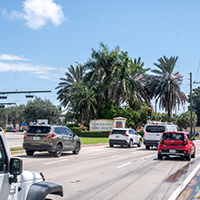 Twin Pairs lane-reduction push ends
Twin Pairs lane-reduction push ends
STORY BY RAY MCNULTY (Week of December 21, 2023)
The “zombie project,” as Vero Beach Mayor John Cotugno dubbed the repeatedly rejected and resurrected push for lane reduction along the Twin Pairs through the city’s downtown, is dead again.
Until at least 2045, anyway.
That’s the next time the Florida Department of Transportation will seek community input for its every-20-years cycle for the resurfacing of State Road 60 in Vero Beach.
For now, though – because the City Council last week rebuffed proponents’ latest effort to reduce that strategic, half-mile stretch of the county’s most-travelled east-west corridor to two lanes in each direction – State Road 60 won’t see any jarring changes after FDOT crews repave the roadway in fiscal 2027.
Instead, when the project is completed, motorists here will notice only minor improvements, which were part of a compromise plan the council voted 4-1 to approve during a special-call meeting two Tuesdays ago.
Lane-reduction advocates argued that the measure was crucial to the city’s efforts to revitalize the downtown area.
The council delivered its final verdict immediately after voting 3-2 to abandon the draconian lane reduction endorsed by Vice Mayor Linda Moore and Councilman John Carroll.
The council’s most staunch and stubborn supporter of the lane-reduction proposal he sought a year ago, Carroll was the lone council member to vote against the late-arriving compromise, which was one of four options considered.
Moore, however, eventually accepted the compromise, which impacts only westbound traffic, restores the traffic-calming measures adopted by a previous council in 2021, and adds only a minor roadway reconfiguration.
The compromise, suggested by Cotugno, eliminates the far-left westbound lane of State Road 60 – only between 14th and 16th avenues, however – and replaces it with landscaped areas between bulb-outs to be constructed at the highway’s intersection with 15th and 16th avenues.
There will still be three lanes of traffic in both directions through downtown.
However, the compromise calls for new crosswalks to be installed at State Road 60’s intersections at 16th Avenue, adjacent to the County Courthouse, and 12th Court, near Jetson’s TV & Appliance store.
The other traffic-calming measures, which FDOT already had approved, include: reducing to 35 mph the speed limit between the Florida East Coast Railway tracks to 20th Avenue; narrowing driving lanes; widening bicycle lanes; and adjusting the timing of traffic signals in the vicinity.
City Manager Monte Falls said the new bulb-out at 16th Avenue addresses a sightline problem for motorists turning west onto State Road 60 – an obvious safety issue – so his staff will ask FDOT to cover the cost of construction.
The bulb-outs at both 15th and 16th avenues will increase safety for pedestrians by reducing the distance they must travel to cross State Road 60, Falls said, adding that installing a crosswalk at 12th Court should provide additional safety there, too.
If FDOT refuses to pay for the bulb-outs, the city’s projected cost for the planned improvements is $385,000. The city’s cost for the more-comprehensive lane-reduction proposal the council spurned would’ve been nearly $2 million.
The council’s recommendation, which came just three weeks before the state’s Dec. 31 deadline, will be sent to FDOT officials, who are scheduled to begin in early 2024 the design phase of the $6.7 million State Road 60 resurfacing, restoration and rehabilitation project.
“We went through the process,” Cotugno said after the meeting. “We commissioned a study. We reviewed the data. We listened to our fellow citizens. We also engaged individually with the community.
“And here we are, a year later, and not everyone is pleased,” he added. “But we managed to keep the discourse civil, and we arrived at a compromise that I believe was the right decision for the community.”
Carroll surely disagreed.
In fact, Carroll continued to lobby for the lane-reduction proposal until minutes before the council voted, despite the community’s overwhelming opposition at public workshops and, again, at last week’s meeting.
In making his last-gasp pitch to the other council members, Carroll dismissed the community’s opposition, saying the public, in general, had “limited knowledge” of the project,” and what it did know was “limited to biased articles written by journalists who are interested in selling advertising.”



